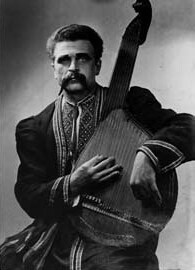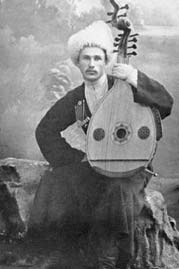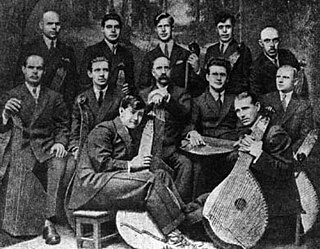
A bandura is a Ukrainian plucked-string folk-instrument. It combines elements of the zither and lute and, up until the 1940s, was also often called a kobza. Early instruments had 5 to 12 strings and resembled lutes. In the 20th century, the number of strings increased initially to 31 strings (1926), then to 56 strings – 68 strings on modern "concert" instruments (1954).

The kobza, also called bandura is a Ukrainian folk music instrument of the lute family, a relative of the Central European mandora. The term kobza however, has also been applied to a number of other Eastern European instruments distinct from the Ukrainian kobza.

Hnat Martynovych Khotkevych was a Ukrainian theater and public figure, engineer, inventor, writer, historian, translator, ethnographer, art critic, playwright, screenwriter, composer, musicologist, violinist, pianist, baritone, bandurist, and teacher. He was shot by the KGB during the Great Terror in the Soviet Union.
The Poltava Bandurist Capella was vocal-instrumental ensemble who accompanied themselves on the multi-stringed Ukrainian bandura. It was initially established in February 1925, based on a male church choir who sang in the Ukrainian Autocephalous Orthodox Cathedral in Poltava under the direction of Fedir (Khvedir) Popadych. The ensemble was disbanded in October 1934.
Kobzarskyi Tsekh, literally "Kobzar guild", is an organization of kobzars, which have existed since the 17th century in Ukraine.
Leonid Haydamaka has left his impression on the development of bandura art in the 20th century.
Kobzars and bandurists were a unique class of musicians in Ukraine, who travelled between towns and sang dumas, a meditative poem-song. Kobzars were usually blind, and required the completion of a three-year apprenticeship in specialized Kobzar guilds, in order to be officially recognized as such. In 1932, on the order of Stalin, the Soviet authorities called on all Ukrainian Kobzars to attend a congress in Kharkiv. Those that arrived were taken outside the city and were all put to death.

The Kharkiv Academic Style of Bandura Playing is a specific method of playing the Ukrainian folk instrument bandura.
The Kyiv Academic Style of Bandura Playing is a method of playing the Ukrainian folk instrument of bandura.

Vasyl' Kostovych Yemetz was a Ukrainian bandurist. He was founder and initial director of the Kobzar Choir in 1918 - the direct protégé of the Kiev Bandurist Capella and the Ukrainian Bandurist Chorus.

Hryhory Ivanovych Bazhul was a Ukrainian bandurist and publisher of articles on bandura history from Poltava, Russian Empire. After World War II he emigrated to Australia settling in Sydney.

Hryhory Pavlovych Nazarenko was a bandura player.

Victor Mishalow is an Australian-born Canadian bandurist, educator, composer, conductor, and musicologist.
A Kuban bandurists is a person who plays the Ukrainian plucked string instrument known as the bandura, who is from Kuban, a geographic region of southern Russia surrounding the Kuban River.

Antin Paplynsky (Ukrainian: Антоній Паплинський was a Ukrainian musical instrument maker who crafted banduras from 1905-1918. He was rumoured to have been shot by the Bolsheviks in 1919 or 1920. Paplynsky's instruments had 32-34 strings and were diatonically tuned. He was a popular bandura maker because of the quality of his instruments. In 1909 he received a Grand Prix award at the World Trade Exhibition held in Paris. His instruments were sought after not only in Ukraine, but in Russia and Canada.
The Honcharenko Brothers—Alexander (1913–2005) and Peter —became the dominant bandura-makers and designers in the Ukrainian diaspora.
The Leontovych Bandurist Capella was a male choir whose members accompanied themselves using a Ukrainian folk instrument known as a bandura. It was established in the displaced persons camps in Germany in 1946 and had an active performance schedule until 1949.

The Hnat Khotkevych Ukrainian Bandurist Ensemble is a vocal and instrumental Ukrainian folkloric performing ensemble in Sydney, Australia. It was founded in June 1964 by bandurist Hryhory Bazhul and since May 1971 was directed by Peter Deriashnyj.

Mykola Petrovych Budnyk was a luthier and traditional performer in the Kobzar tradition. He was active in authentic construction and recreation of historic folk instruments, and involved in the movement for authentic performаnce practice on Ukrainian folk instruments. Budnyk was also known as a painter and poet. He was born in 1954 in Skolobiv, near Khoroshiv, Zhytomyr region, and died January 16, 2001, in Irpin', Kyiv region.








